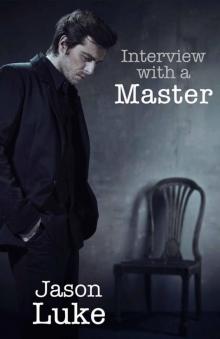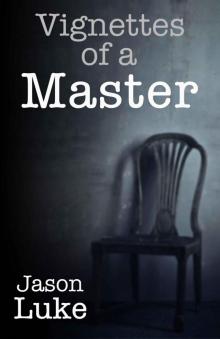- Home
- Jason Luke
The Light House Page 17
The Light House Read online
Page 17
Her hands went to her mouth and she gasped. It felt as though the breath had been punched from her – snatched away by the impossible beauty.
The image was rendered flawlessly, capturing an essence of longing and yearning that gave the painting an air of poignant perfection. She stepped towards it, fearful that the illusion might somehow be dispelled, but instead it became even more powerful as she came closer. She studied the canvas in awed incredulity, shaking her head, feeling a mist of tears well in her eyes. It was as though she were looking at a perfect twin – a miracle of skill that gave the image life and energy and dimension.
“It’s stunning!” Connie said at last. She heard the little tremor of emotion in her voice and could feel the running beat of her heart. Somehow, in some way she could not explain, the painting had the lustrous qualities of light and life.
Blake stood back, gratified by Connie’s reaction. He could see in the set of her body and in the tone of her voice that her pleasure was genuine. “Don’t touch it,” he warned. “Parts of the painting will still be wet.”
He went and crouched beside her. He snatched up the thick-rimmed glasses from his paint table and they stood shoulder-to-shoulder for many quiet minutes, inspecting every inch of the canvas. Blake’s eyes were critical, looking for small flaws. Connie’s eyes were wide with head-shaking awe.
“It’s like you captured the essence of me – my soul,” Connie said in a husk. “But she’s too beautiful to be me, Blake. The woman in your painting – she’s so perfect, so utterly real with emotion and grace and… and all the qualities that I don’t have. But she looks like me…” Connie fell into a wondrous silence for a long moment as though grappling to understand how the figure in the painting could be a mirror of her, and yet evoke so many feelings and subtle qualities in just her expression, her presence. “How did you do that?”
Blake felt a lump choke off his breathing and fought to suppress it. “I painted you how I saw you,” he said softly. “I painted you through adoring eyes, Connie.”
She snapped her head around – their faces were just inches apart, and Blake saw the deep swirl of sentiment move like a passing shadow behind her gaze.
“It’s the best thing you have ever painted,” Connie whispered, the words said thick with her own disbelief that such a thing could be possible. “I thought you were the greatest seascape painter of our generation… but you’re even better at portraits. Blake – this is the kind of art that hangs in museums, not just galleries.”
He dismissed her praise with a wry smile, but inside he was chuffed with pride. Connie’s admiration was glowing, and he felt unaccountable satisfaction. She was no critic, he realized. But she was the inspiration for the painting, and her approval mattered more than any critical acclaim.
He set the glasses down, rubbed his knuckles at his eyes to try to clear the blur. He stood up straight, went back a few paces and patted Ned’s head. The Great Dane yawned, reveling in the small amount of unexpected attention.
“What do you think Ned?”
The dog leaned against him, heavy as a falling boulder so that Blake had to brace himself to hold his balance. Ned waited patiently until Blake scratched his back.
Connie turned to him from where she was crouched. “What are you going to call it?”
Blake shrugged. “Does it matter?”
Connie looked aghast. “Of course it matters!” she declared. “All the great paintings throughout history are known by a name.”
Blake gave her a small indulgent smile. “Well I really haven’t thought about it,” he said. “How about ‘Woman Standing By a Window’?”
Connie’s expression became mortified. “You’re joking, right?”
“Well why don’t you come up with a name?”
Connie thought seriously. She turned once more back to the painting, consumed by every inch of perfection. The rose was exquisite – so real she had the urge to inhale its fragrance. She noticed, too, how bright and clear were the whites of her eyes now, when set within the rest of the colors.
“It has to be a good name – something worthy of the painting. What about ‘Woman at the Light House’?” she offered. “How about that?” She turned back to Blake to gauge his reaction.
“Sure.” Blake said. To him it really didn’t matter. And then, suddenly it did. A better name struck him. “How about we call the painting ‘Lady of the Light House’?”
Connie liked that name best of all.
42.
“What will you paint next?” Connie asked sweetly.
They were walking hand-in-hand in the wet sand. Further along the beach, Ned was running with his tongue lolling from the side of his mouth. The dog was weaving in and out of the surf line, splashing amongst the waves, and then scampering away towards the rocky promontory in pursuit of gulls.
“I have no idea,” Blake admitted. It was a clear and perfect afternoon. The sky was blue, the sun was warm on his face, and he was content. Connie’s hand within his felt natural, and the brush of her hips and shoulders against him as they walked along the hard wet waterline was intimate.
“What about a still life?” Connie swept the breeze-blown hair from her face and looked up into his eyes. “Every great master of the past painted still life. Maybe you should give it a try.”
Blake looked bemused. “You mean pieces of fruit?”
“It doesn’t have to be fruit,” Connie frowned. “What about silverware, or different pieces of glass? I’m trying to think about the kind of things that would give you a new challenge – objects that would stretch your ability.”
Blake suddenly laughed. “I knew another artist who painted still life,” he said suddenly. “He painted from life – no reference photos, but he was also damned slow at his craft, so he went and bought pieces of imitation fruit. That way he could leave the setting for days or weeks without having any of his display spoil.”
Connie nodded. She didn’t see anything funny in the tale. “That makes good sense…” she said, the words lifting her voice into a kind of question.
“In theory, it did,” Blake was still smiling. “But he was a realism painter, just like me – and pretty good at what he did. He painted the pieces so well that the critics complained his fruit looked too plastic.”
They laughed together, the sound echoing along the lonely beach and carried on the gentle breeze. Blake slipped his arm around Connie’s waist and pulled her a little closer.
“Would you think about painting a still life if I asked Thad to bring some real fruit, next time he makes a grocery delivery?” Connie persisted, bringing the conversation back on point.
Blake nodded without any conviction. He had slain his dragon. He had made a painting that was perfect in his eyes, and he realized then that there were no worlds left he wanted to conquer. The portrait had been his last painting.
“Maybe,” he said without interest. “But right now I’m happy to spend time in the sun with you. Painting can wait. I don’t have any plans for what lies ahead.”
Connie stopped on the sand, her expression piqued. “Didn’t the last couple of weeks inspire you again, Blake?” she sounded incredulous. “Didn’t you feel the old thrill of having your skills come back to you, a resurgence in your passion for painting?”
Blake became serious. They were standing within the embrace of each other’s arms, the sand between their toes and the lapping hiss of spent waves running over their feet. He gazed into her eyes.
“No,” he said, and she could see that he meant it. “Connie, my vision is going, faster than I thought. I wasn’t inspired to paint again. That’s not why I made the portrait. I wanted redemption, not a new career.”
“But you’re so brilliant!” she protested. “Can’t you see that it’s a waste of your gift if you don’t continue to paint?”
He shook his head. “Not once in those two weeks did I allow myself to get excited about art again,” he said without tone or timbre in his voice. “Because I knew it would b
e futile, Connie. How many blind artists are there in the world?”
“There must be some.”
“Name one. Name a famous one.”
Of course, she couldn’t.
43.
Connie and Blake were on the beach together two days later when the unexpected sound of a truck’s diesel engine made them both look up towards the house in curious surprise.
They glanced at each other – it wasn’t delivery day from the grocery store – and then they went sprinting up across the hot sand with Ned streaking away ahead of them, his bark like a boom of thunder.
It turned into a race, and Connie won by a couple of paces.
They pulled up, gasping and laughing before a medium-sized delivery truck, its engine still belching diesel exhaust. A dazed driver in a blue sweat-stained uniform climbed down from the cab. He was holding a clipboard and wore the harried, slightly bewildered expression of a man who had driven towards the ends of the earth – and finally found it.
He pushed the cap he was wearing to the back of his head.
“I am looking for Miss Connie Dixon.”
Blake stepped forward. “That’s me,” he said with a straight face. Connie punched him on the arm.
The man went to the back of the truck and carried a cardboard box to Connie. “From New York,” the driver said and then squinted at his clipboard. “Cartwright Gallery. I’ll need you to sign for the delivery.”
Blake carried the box inside for her and set it on the living room floor. He went into the kitchen, found a pair of scissors, and came back brandishing them. Connie flung her body over the box as though he was about to do murder.
“No!” she squealed. “You can’t see my paintings.”
Blake stopped dead. “You’re kidding, right?”
“No, I am most certainly not,” Connie clutched the box protectively to her. “They’re not good enough for you to see. They were painted years ago.”
“But Connie, I want to see them.”
She shook her head. “I would be too embarrassed.”
Blake set the scissors down. “I showed you all of my old paintings,” he said reasonably. “It’s only fair that you should show me your work.”
“Blake, we’re in different leagues!” Connie’s voice became a whine. “I was an amateur. I didn’t have your skill, your experience, or your knowledge. My work compared to yours would be…”
“Leave me to be the judge of that,” Blake softened his voice, like he was trying to gently coax a jumper off a ledge. “And besides,” he laid down his trump card, wrapping his tongue gloatingly around his next words, “you promised there would be no more secrets between us, remember?”
Connie capitulated with a groan of despair. She made a sad face, one last silent plea for mercy. Blake shook his head with a half-smile on his lips.
“Okay,” she pouted. “But let me take them into the studio and arrange them. When I have them displayed, I will call out to you.”
She went down the corridor and slammed the door to the studio closed behind her. Blake paced across the floor like an impatient parent in a waiting room, and it was almost an hour before he heard the faint strain of her voice, a conflict of excitement and trepidation. He went towards the studio and stopped dramatically in the doorway.
There were a dozen small paintings on display, each one about a foot square. Connie had set two of them side-by-side on the easel’s crossbar, and a couple more against the window. The rest were dispersed around the studio walls. None of the paintings were framed.
Connie stood in the middle of the floor, her arms folded across her chest and her bottom lip trapped between her teeth. She watched Blake’s face closely, and he realized she was anxiously reading his expression.
He went slowly towards the two paintings that she had displayed on the easel. One was a still life, with a bowl of grapes in the center of the canvas. Behind the bowl he could see the folds of a curtain. He picked up his glasses, set them on the end of his nose, then turned his attention to the adjoining piece. It was a painting of a seascape – a single wave curling out of the ocean with a foaming white crest. Blurred into the far distance, seeming to float on the horizon line, was a non-descript headland. Blake folded his glasses and slipped them into his shirt pocket.
He went around the room, looking at the rest of Connie’s paintings. His expression was rigid, his gaze sweeping over each piece, then coming back again as he inspected them more carefully. At last, Connie could stand the strain of his silence not a minute longer.
“Well?” she gasped, as if she had been holding her breath. “Tell me what you think, and don’t spare my feelings. I don’t want you to be nice to me, I want you to be honest.”
Blake looked at her sharply. “You really want me to be honest?”
“Yes,” Connie said firmly, and then added in a meek, faltering voice, “I think so…”
He intimidated her. He was Blake McGrath, the finest artist in the world and by far the most successful realism painter she had ever studied. He was a living legend, and suddenly the realization of his reputation made her inwardly cringe.
He went back to the still life on the easel and picked it up carefully. He peered close to the canvas for another long moment, and then looked up at Connie. He took a deep breath.
“If your aim was to paint in a naïve style, similar to, say, Henri Rousseau, I would say you definitely have some potential,” Blake said carefully. “I see the same simplicity, without some of the detail work the Frenchman was known for.” He set the canvas down and picked up the seascape. “As primitive Post-Impressionist pieces, then they are quite good.”
Connie nodded. She didn’t smile with relief, or gratitude. She simply inclined her head and urged Blake to continue.
Blake looked back at the seascape in his hands and shrugged.
“However, if you were trying to paint in the style of Realism…” his voice trailed away to silence because he decided tactfully that the rest of his conclusion was better left unsaid.
“Go on…” Connie said sweetly, and Blake was instantly alarmed. There was ice in her voice and he felt the ground beneath him suddenly become precarious with looming peril.
“No,” Blake said and hung his most charming smile from the corner of his mouth. He shrugged. “Connie, art is all subject to interpretation. The way one person sees art is always different to the way another person views it. In fact it’s the same with music, films, books… everyone is going to have a different opinion, and there is nothing that makes one person right, and another person wrong.” Blake glanced at the studio door and tried to calculate his chances of escaping down the hallway safely. Connie was circling him and her mouth seemed frozen and covered in crystals of ice. There was a sparkle in her eyes like the pointed tip of a stiletto.
“I’d like to hear your interpretation,” Connie insisted. “As the best realism painter in the world, and the darling of the critics, you above everyone else must be eminently qualified to critique my work – my realism paintings.”
Blake was trapped. The slippery ground beneath him was cracking wide open into fissures. He took another breath, realizing that Connie would not be deflected.
“Okay,” he said at last. “As realism paintings, they are awful.”
He braced himself. Connie made her eyes wide and artless, and for a moment Blake was unsure of her reaction. He rushed to fill the void, hoping to minimize the damage to her feelings. “The difference is brush mileage,” he explained. “You said yourself that you only focused on your art for a limited time. Connie, I’ve had years and years at an easel. Of course you can’t compare your experience to mine. At the same stage in our careers, your paintings were probably better than the work I had created.” He threw the compliment out and hoped she would be mollified.
Connie came towards him with a slow kind of stealth that made him nervous. There was a smile fixed on her face, but it looked perilously close to a snarl.
“Then perhaps you will gi
ve me an art lesson?” she asked with delicate sweetness. “Perhaps the great man can show me some of his legendary secret tips and techniques…”
Blake thought quickly. “Will it get me out of the dog house?”
Connie arched her eyebrows. “It might.”
He nodded. “Okay,” he said. “Choose an image you want to paint and I’ll show you some of the things I discovered – but only if you stop looking like that. You look scary.”
Connie gave a little grin of triumph.
44.
In a quiet moment of reflection, Connie realized that her own passion to be a painter had never left – the flame had still flickered. Duncan Cartwright had cruelly tried to extinguish her dream and so – with no other apparent alternative – she forsook the desire to become an artist and instead fostered a fresh dream to own an art gallery. Owning a gallery would give her the opportunity to remain involved in the industry, even if she couldn’t earn a living from creating her own works.
Now, she had the opportunity to learn painting techniques from Blake McGrath, and the prospect filled her with extraordinary excitement, so that she spent the afternoon pouring through the thousands of seascape images Blake had photographed throughout his career, each picture filed and referenced on a memory stick.
Quite suddenly, the dream she had abandoned sparked into flame again – not so bright that she would ever abort her plans to open her gallery – but enough to inspire her to re-explore her love of painting, even just as an enthusiastic hobbyist.
“I chose this one,” she came at last to Blake and showed him the photo on her laptop. It was a photo he had taken many years ago depicting a steep ledge of sand dunes in the foreground leading down onto a golden sandy beach. The mid-distance showed a procession of waves rolling in to the shore, and then a far-off headland under a warm afternoon sky. Blake glanced at the image and nodded his head.
“Fine,” he said. “Now you need to choose a canvas and then project the image.”

 Interview With a Porn Star
Interview With a Porn Star Jonah Noble - Anticipation Is Everything
Jonah Noble - Anticipation Is Everything In Love With a Master
In Love With a Master Intimate
Intimate Interview With a Master
Interview With a Master Man and Master
Man and Master Master Class
Master Class Vignettes of a Master
Vignettes of a Master The Word Master
The Word Master